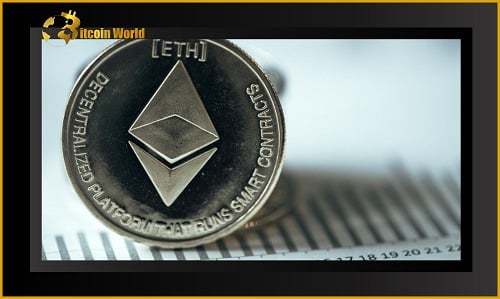Exciting times in the crypto world! Ethereum (ETH) has been on a tear, smashing through resistance levels and surging past the $2,700 mark. Did you catch this upward swing? Let’s dive into what fueled this price jump and what could be next for the world’s second-largest cryptocurrency.
Ethereum’s Impressive Climb: What Happened?
After comfortably settling above $2,450, Ethereum demonstrated strong bullish momentum. The price action wasn’t just a small bump; ETH built a solid foundation above $2,500, signaling strong buyer interest. Key milestones included:
- Breaking Barriers: ETH decisively broke through the $2,550 and $2,580 resistance zones. These weren’t minor hurdles; overcoming them indicated significant bullish strength.
- Trendline Takeover: On the hourly chart (ETH/USD), a significant downtrend line that had been acting as resistance near $2,580 was convincingly broken. This trendline break often signals a shift in momentum.
- Comfort Above Key Averages: Ethereum didn’t just spike and retreat. It comfortably settled above $2,600 and the crucial 100-hour simple moving average. This is a strong technical indicator of sustained upward pressure.
- Reaching New Heights: The bulls took charge, propelling the price beyond $2,700 and peaking near $2,728. This peak represents a significant short-term high.
- Consolidation Phase: Currently, ETH is taking a breather, consolidating its gains around the $2,700 level. This consolidation is a healthy sign, potentially setting the stage for the next move.
Zooming into the technicals, the price is holding well above the 23.6% Fibonacci retracement level. This retracement is measured from the recent swing low of $2,445 to the high of $2,728, indicating that the current consolidation is within a healthy bullish range.
Key Price Levels to Watch for Ethereum
For traders and investors, understanding key resistance and support levels is crucial. Let’s break down the immediate levels to watch:
Resistance Levels (Where ETH Might Face Selling Pressure):
- Immediate Resistance: $2,725. This level is the immediate hurdle. A break above this could signal further upward movement.
- First Major Resistance: $2,750. This is a more significant resistance zone. Overcoming $2,750 would strengthen the bullish case considerably.
- Next Big Hurdle: $2,800. Psychologically and technically, $2,800 is a major resistance level. A decisive break above this could trigger a rapid price surge.
- Potential Target: $2,880. If the $2,800 resistance is conquered, $2,880 becomes a plausible next target in the short term.
Support Levels (Where ETH Might Find Buying Interest):
- Initial Support: $2,660. On the downside, $2,660 acts as the first line of defense. If the price dips, buyers might step in around this level.
- Stronger Support Zone: Around $2,640 & 100 Hourly SMA. The $2,640 area, coinciding with the 100-hour simple moving average, presents a stronger support zone. A dip to this level could be viewed as a buying opportunity by some.
- Critical Support: $2,580. This level is crucial. It’s near the 50% Fibonacci retracement level (from the $2,445 low to $2,728 high) and represents a significant support area. Holding above $2,580 is vital for maintaining the short-term bullish outlook.
- Major Support Zone: $2,500. In case of deeper corrections, the $2,500 level is a major psychological and technical support zone. A drop below this could signal a shift in short-term momentum.
What’s Next for Ethereum? Bullish or Bearish Scenario?
The million-dollar question: will Ethereum continue its ascent, or is a correction on the horizon?
Bullish Scenario:
- Continued Momentum: If Ethereum successfully breaks above the $2,725 and then the $2,750 resistance levels, we could see a continuation of the upward trend.
- Targeting Higher: Conquering $2,800 could open the door to test higher targets, potentially reaching towards $2,880 and beyond in the near term.
- Market Sentiment: Positive overall crypto market sentiment and continued interest in Ethereum 2.0 and the broader Ethereum ecosystem could fuel further gains.
Bearish Scenario:
- Failure to Break Resistance: If Ethereum fails to push decisively above $2,725 and faces strong rejection at higher levels, a downside correction becomes more likely.
- Testing Support Levels: A failure to break higher could lead to a retest of the support levels at $2,660, $2,640, and potentially $2,580.
- Broader Market Factors: Negative news in the broader crypto market, regulatory concerns, or a downturn in Bitcoin’s price could also exert downward pressure on Ethereum.
Key Takeaways for ETH Traders
Here are some actionable insights for those trading or considering trading Ethereum:
- Watch Resistance Levels Closely: Pay close attention to how ETH behaves around the $2,725 and $2,750 resistance zones. A breakout above these could present buying opportunities.
- Monitor Support Levels: Keep an eye on the support levels, especially $2,660 and $2,640. These levels could offer potential entry points on dips.
- Stay Informed: Keep abreast of broader crypto market news and developments, as these can significantly impact Ethereum’s price.
- Manage Risk: Always practice proper risk management. Use stop-loss orders and avoid investing more than you can afford to lose.
In Conclusion: Ethereum’s Price Action is Heating Up
Ethereum’s recent price surge above $2,700 is definitely grabbing attention. While the short-term outlook appears bullish, it’s crucial to watch the key resistance and support levels we’ve discussed. Whether you’re a seasoned crypto trader or just starting to explore the world of digital assets, keeping a close eye on Ethereum’s price movements can offer valuable insights into the dynamic crypto market. Will ETH continue its rally, or will we see a pullback? Only time will tell, but for now, the Ethereum market is certainly one to watch!
Related Posts – Ferrari joins the NFT universe through a collaboration with a Swiss…
Disclaimer: The information provided is not trading advice, Bitcoinworld.co.in holds no liability for any investments made based on the information provided on this page. We strongly recommend independent research and/or consultation with a qualified professional before making any investment decisions.


